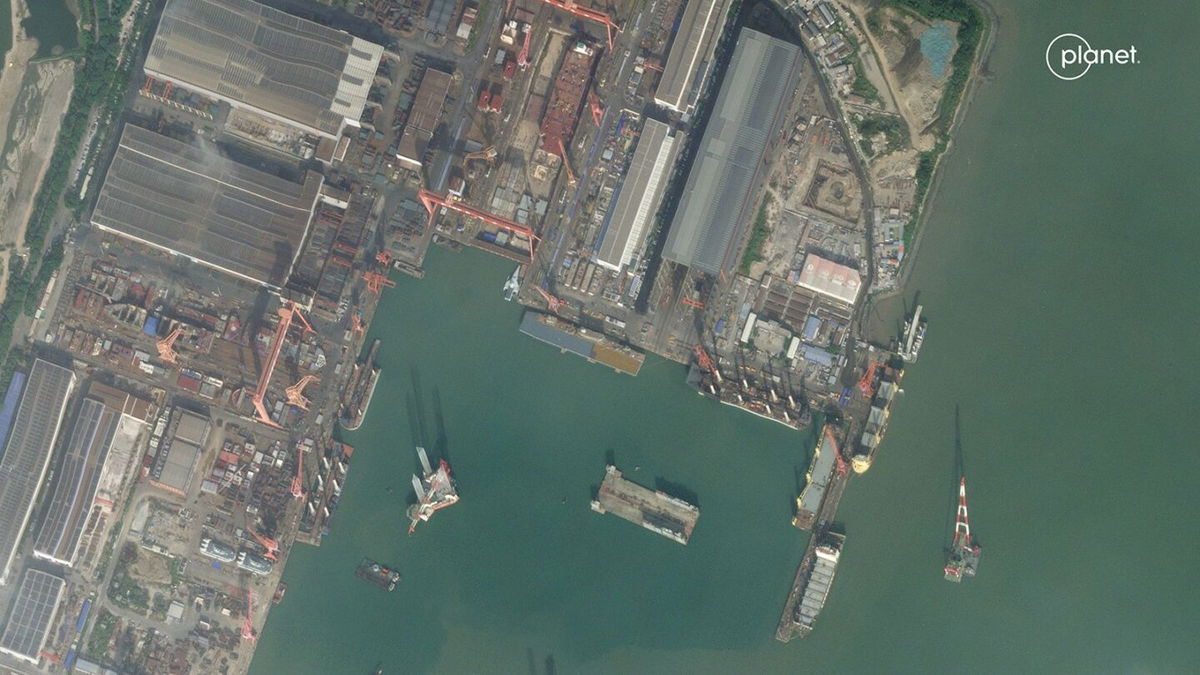Satellite imagery shows mystery ship built in China amid breakneck naval expansion

Another view of the satellite imagery captured on October 23
By Edward Szekeres and Brad Lendon, CNN
Hong Kong (CNN) — China appears to have built a new and unusual aircraft carrier, intriguing experts with a potentially first-of-its-kind vessel that could further increase Beijing’s rapidly expanding maritime power.
Satellite imagery from Planet Labs shows a vessel with a large, open flat top under construction at Guangzhou Shipyard International on Longxue Island, in the southern province of Guangdong.
This potential new aircraft carrier “is of a somewhat unusual shape and size – much smaller than China’s previous naval aircraft carriers,” said Thomas Shugart, a former US Navy submarine commander and now a fellow at the Center for a New American Security.
But the vessel is even smaller than the Type 075 amphibious assault ships used by Beijing’s navy, suggesting that China may be building the world’s first “ostensibly civilian ‘aircraft carrier’ as an oceanographic research vessel of some sort,” Shugart added.
The existence of the new vessel was first reported by The War Zone.
China has been churning out increasingly advanced warships at a feverish pace, often matching US carrier technology.
The aircraft carrier Fujian – by far China’s biggest, most modern and most powerful carrier to date – headed to sea for its first trials earlier this year, with experts saying it could join the People’s Liberation Army Navy (PLAN) fleet by 2026.
The 80,000-ton carrier dwarfs the PLAN’s two active carriers, the 66,000-ton Shandong and the 60,000-ton Liaoning, putting it in the league of supercarriers. Only the United States Navy operates aircraft carriers bigger than the Fujian.
Naval fusion
China has also made rapid progress on the construction of the world’s largest amphibious assault ship, according to the Center for Strategic and International Studies, a Washington think tank.
Dubbed Type 076, its flight deck spans approximately 260 meters (853 feet) by 52 meters (170 feet), which is over 13,500 square meters – nearly the area of three US football fields, the think tank said in its satellite imagery analysis.
Built in Shanghai, carrier Fujian and the Type 076 are the crown jewels of a military expansion that has seen Beijing grow its navy into the world’s largest, with more than 340 warships to its name.
But the construction of a novel aircraft carrier-type vessel in southern China could signal another shift toward Beijing’s proclaimed “military-civil fusion strategy that employs things like dual-use civil-military vessels,” said Shugart, the former submarine commander.
The vessel potentially “provides a low-cost addition to the PLA Navy’s operational capabilities in a low-threat environment and its logistical capabilities,” said Carl Schuster, a former director of operations at the US Pacific Command’s Joint Intelligence Center.
Given its light construction, the ship might serve as a helicopter or drone carrier for the China Coast Guard, which is increasingly deployed as a quasi-military force, Schuster said.
“Possessing an aviation platform would expand (the Coast Guard’s) surveillance capability in the distant waters of the southern South China Sea and potentially east of Taiwan,” Schuster added.
China launched large-scale military drills around Taiwan earlier in October, flying a record number of fighter jets and other warplanes around the island. The one-day military exercises, the latest in a series of recent war games conducted by Beijing against its neighbor, displayed an unprecedented involvement of Coast Guard vessels that operated in areas around Taiwan and its outlying islands of Matsu and Dongyin, just off China’s southeastern coast.
“The new flattop would be a significant addition to any Coast Guard quarantine enforcement operation such as that potentially practiced two weeks ago and over the last two years,” Schuster said.
Beijing has become more assertive in its home region, using the military to press its claims in the South China Sea and intimidate Taiwan – a self-governing democracy that China’s ruling Communist Party has vowed to take, by force if necessary.
But the new vessel could also be very useful in a humanitarian capacity, providing quick and cost-effective relief and evacuation in non-combat situations, Schuster said.
“It could also serve as a logistics support and repair ship in an amphibious operation once the beach was secured,” the expert added.
“It is too frail to enter a contested beach area, but they might consider it in desperate situations.”
First two-carrier exercise
In another exhibition of China’s growing naval power, the Liaoning and the Shandong completed their first-ever dual-carrier exercises in late October, according to the state-run Xinhua news service.
An aerial photo of the exercise showed the two carriers steaming side by side, with fighter jets overhead and at least 11 support ships from their carrier strike groups trailing.
Conducted in the South China Sea, the exercise was “aiming to enhance the integrated combat capability of the aircraft carrier formations” and was “part of the Liaoning aircraft carrier formation’s regular real-combat training in the high seas,” Xinhua said.
Schuster, the former US Navy captain, called the exercise “yet another indicator of the PLA Navy’s growing maritime capabilities.”
“Twin carrier operations add another level of complexity to a fleet’s operations,” he said, with the exercise enabling the fleet to test logistical requirements and coordinate communications among the ships in the flotilla.
The state-run Global Times quoted a Chinese naval expert, Song Zhongping, as saying the exercise enabled the two carriers to “complement each other’s strengths and consolidate their advantages.”
“The Liaoning and the Shandong may have different numbers of aircraft carried, different escorting vessels, and thus distinct capabilities for air defense, anti-submarine warfare, and anti-ship operations,” Song said in the Global Times report.
The-CNN-Wire
™ & © 2024 Cable News Network, Inc., a Warner Bros. Discovery Company. All rights reserved.



